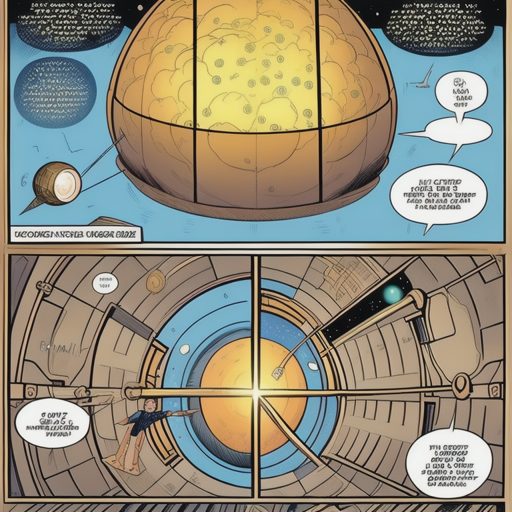
Galactic Hide-and-Seek: Neutrinos Spotted!
Recommended for Preparatory Grades
Hey there! We’ve got a super exciting story to tell you. Scientists have discovered something amazing about our very own Milky Way galaxy! They found something called “neutrinos” coming from the center of our galaxy. Can you believe it? These neutrinos are like tiny, mysterious particles that can zoom through stuff without making a sound or a ripple. They’re pretty sneaky!
You see, scientists have been trying to find these ghostly neutrinos for a long time, but they were always hidden from us. Finally, the scientists figured out a new way to detect them, and ta-da! They found neutrinos coming from the heart of the Milky Way.
Now, let us tell us why this is such a big deal. These neutrinos can teach us so much about the universe. They might help us understand something called “cosmic rays.” Cosmic rays are these super high-energy particles that play a role in creating the neutrinos. And guess what? Neutrinos are special because they’re not like the light we see. They’re like a secret lens that helps us study the structure of our galaxy in a whole new way.
A clever physicist named Naoko Kurahashi Neilson from Drexel University invented a method that helped the scientists make this incredible discovery. She said, “Now we see, for the first time, our galaxy in something other than light.” Isn’t that mind-boggling?
Galactic Neutrinos: Cosmic Secrets Unveiled!
- Let’s dive into how these neutrinos are formed. When really powerful radiation from cosmic rays interacts with matter, it creates something called “pions.” And when these pions break down, they produce neutrinos. It’s like a never-ending process of making neutrinos in the dense disk of the Milky Way. These neutrinos are super duper light and have no charge at all. They’re like little time capsules that hold secrets about where they came from.
- To find these sneaky neutrinos, scientists used something called the IceCube experiment. It’s a bunch of light sensors buried deep in the ice in Antarctica. These sensors can spot the tiniest flashes of light when a neutrino collides with the ice. They’ve been doing this for ten whole years! But guess what? They could only detect neutrinos from outside our galaxy until now.
- The tricky part was that the Milky Way’s disk is mostly in the southern half of the sky. And that’s where the IceCube is located. So, there was a lot of noise from other things, like atmospheric neutrinos, that made it hard to find the Milky Way’s neutrinos. But our smart scientists found a way to filter out the noise using fancy computer learning. It’s like putting on glasses and seeing things clearly!
- With this new method, they found way more promising neutrino signals than before. It would have taken 75 years to find them the old-fashioned way. Can you imagine waiting that long? Machine learning made it so much faster and cooler!
- Here’s the coolest part: the scientists compared the neutrinos with another thing called “gamma rays” from the Milky Way. They both had the same origin! That means these neutrinos were born from cosmic rays right there in the Milky Way’s disk. It’s like discovering a hidden treasure.
- Now, these neutrinos can help scientists answer even more questions. They can tell us where cosmic rays come from. They might come from things like supernovae remnants or active galactic nuclei. Or maybe it’s a mix of different sources. We’re not sure yet, but the neutrinos will help us figure it out.
- Oh, and there’s something called “dark matter.” It’s a mysterious substance that we can’t see, but it’s everywhere in space. Neutrinos might be the key to unraveling the secrets of dark matter too! How cool is that?
- So, my little friend, this discovery is like a big leap for science. It’s like looking at the galaxy with brand new eyes. We’re learning so much more about our home, the Milky Way, and the universe around us. And who knows what other exciting things we’ll discover in the future?
- Keep your eyes and ears open because science is full of surprises!
Similar Stories
Watch a video
Get ready to dive into the mind-blowing world of Neutrinos with the amazing YouTube guru, “Discovery UK!”
Curious Times is a leading newspaper and website for kids. We publish daily global news aligned to your learning levels (also as per NEP 2020): Foundational, Preparatory (Primary), Middle and Senior. So, check out the News tab for this. We bring kids’ favourite Curious Times Weekly newspaper every weekend with top news, feature stories and kids’ contributions. Also, check out daily JokesPoke, Tongue Twisters, Word of the Day and Quote of the Day, kids need it all the time.
Curious Times News Program for Schools for FREE. Over 5,000 schools and teachers from all over the world have joined our programme so that students and teachers can get FREE Educative Newspaper. Here, kids can take part in world events and win prizes and certificates for free through their schools.
Moreover, schools are sharing important School News, like interviews with the principal, notices about new students, contests, and results, not just on social media but also on a news website for kids and other schools.
Thus, do not wait any further, sign-up for your school for FREE.
The following social media platforms allow you to communicate with us: WhatsApp, Instagram, Facebook, Youtube, Twitter, and LinkedIn.
0 (Please login to give a Curious Clap to your friend.)
